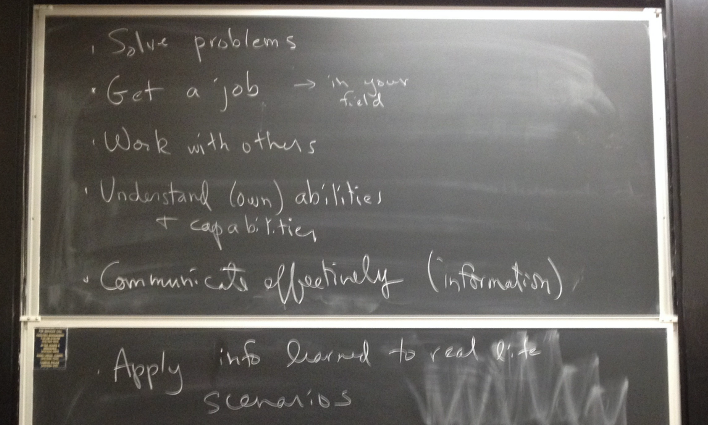Saturday December 12th, 2020

In a recent class discussion, I asked a room of mostly seniors, "What should a person with a university degree be able to DO?" They answered: Solve problems, communicate effectively, be independent, think critically, get a job (in their field), and be a useful member of society. A few months previously, a group of us faculty were asked to answer the same question at teaching workshop. What shocked me is that the faculty answers and the student answers were exactly the same. These skills make a college education important.
If these are our shared goals -- goals as teachers and goals as students -- it is imperative to ask how does the way we conduct our classes support these high-level learning objectives? In my experience, traditional lectures are not designed to support these goals. Lectures can be eloquent, passionate, and inspiring. For most learners, however, lectures do not help them to think independently, to communicate better, or think critically. Many students try to drink from the firehose of knowledge and find themselves drowning.
Searching for a way to teach that addressed these learning goals led me to the Process Oriented Guided Inquiry Learning (POGIL) approach. In POGIL, students construct their own knowledge through a learning cycle of exploration, concept invention, and application. Students progress through carefully constructed worksheets in small groups to explore a ‘model’ (an information rich data display), answer questions that make them think about the model, propose explanations for what they have explored, and then apply those concepts to further problems. The approach is based on years research, and lots of evidence points to improved learning, attitudes towards the discipline, and process skills.
I have now developed physical chemistry courses at both the graduate and undergraduate levels using a POGIL approach, and I have been humbled and astounded by the results. Previously, I worked hard to make excellent lectures that were clear, informative, and interesting. But the students like the POGIL better; and I like the POGIL better. Both the strongest students and the least prepared students appreciate the way guided inquiry works. The weaker students have explicit permission to ask questions of their peers when they don't understand and working with peers can help uncover the misunderstandings in what they thought they knew. The strongest students relish the freedom to follow their own thinking and feel the satisfaction of solving the puzzles that are the world we live in. And I like it; I find that more students engage with the material at a deep level. We could be talking about the intricacies of coherences in quantum mechanics or the meaning of negative temperature in statistical mechanics -- these topics are hard to understand, which makes them interesting. Even experts struggle to understand what these things really mean; for students to share the intellectual excitement inherent in these ideas is a major victory.
As successful as I have found POGIL is in the classroom, the COVID-19 pandemic has transformed my classroom. I like to be with people. I like to see the looks on their faces and their body language and the myriad non-verbal cues to their state of mind. Before the pandemic, I figured that POGIL could never succeed outside of an in person setting. Over this last year I put that idea to the test. I taught a 264 student section of General Chemistry 1 at the University of Pittsburgh completely online. The growing pains hurt. The cognitive load overwhelmed me at first – I had to manage the presentation, how I look on camera, the chat window, the participants panel, the breakout rooms, and the Teams chat to communicate with my undergraduate cofacilitators. As I figured out the technology, however, things started to move more smoothly. Once students moved into their breakout rooms, I could see the students engage with the material and with each other. There were even some advantages over the traditional large lecture hall. In our stadium seating lecture hall, teams of more than three students had to struggle to see and hear each other; in the video breakout rooms, students had a more private and direct space to discuss, debate, get confused, discover answers, laugh, and share. Other little things also felt meaningfully better. I could use every student’s name when I talked with them – as hard as I have tried, I have never gotten close to that in real life! At the same time, however, there were challenges that I had never seen before: teams of students together in a breakout room with their cameras and microphones off, together in their isolation. I am still trying to learn how best to guide students like these toward more productive, and fun, working strategies. Nevertheless, the class worked. Balancing the challenges and the opportunities, I was amazed at how well the core of the POGIL approach still worked, far beyond the bounds of what I thought possible.
We go to college not just to learn a discipline, but to grow -- as scholars, as citizens, as people. Teachers are lucky enough to go to back to college every day.
Sean Garrett-Roe, University of Pittsburgh
